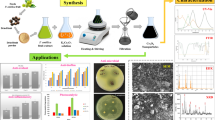Abstract
The work studies the photocatalytic activity and the antifungal efficiency of the TiO2/Zn-Al coatings placed on the target commercial façade paints. The photocatalytic active nanocomposite based on TiO2 and Zn-Al-layered double hydroxides (ZnAl-LDHs) was synthesized by a wet impregnation technique with 3 % w/w TiO2. The freshly prepared suspension was applied by spray technique on the surfaces of the white façade paints. The goal of the work was to develop a method that quickly quantifies the antifungal activity of the commercial façade paints with and without biocidal components covered with a photocatalytic coating. The essence of the proposed method is the monitoring of the fungal growth (artificial ageing conditions) and the quantification of its development (UV-A 0.13 mWcm−2) on the façade paint surfaces. A special fungus nutrient (potato dextrose agar (PDA)) was inoculated with the spores of the Aspergillus niger ATCC 6275, and the test samples (façade paints with and without photocatalytic coating) were placed on the inoculated nutrient in the petri dishes. The images of the fungal growth on the samples of the facade paints, during a period of 5 days, were imported into Matlab R2012a where they were converted to binary images (BW), based on the adequate threshold. The percentage of the surface coverage was calculated by applying the specifically written program code which determines the ratio of the black and white pixels. The black pixels correspond to the surface covered with hyphae and mycelia of the fungus.







Similar content being viewed by others
References
Bergamonti L et al (2013) Synthesis and characterization of nanocrystalline TiO2 with application as photoactive coating on stones. Environ SciPollut Res. doi:10.1007/s11356-013-2136-5
Bhushan B, Jung YC (2011) Natural and biomimetic artificial surfaces for superhydrophobicity, self-cleaning, low adhesion, and drag reduction. Prog Mater Sci 56:1–108
Coutu S, Rota C, Rossi L, Barry DA (2012) Modelling city-scale facade leaching of biocide by rainfall. Water Res 46:3525–3534
Directive 98/8/EC of the European Parliament and of the Council of 16th February 1998 concerning the placing of biocidal products on the market, 1998
Evans P, Mantke S, Mills A, Robinson A, Sheel DW (2007) A comparative study of three techniques for determining photocatalytic activity. J PhotochPhotobio A188:387–391
Furuse AY et al (2008) Colour-stability and gloss-retention of silorane and dimethacrylate composites with accelerated aging. J Dent 36:945–952
Gartner M, Trapalis C, Todorova N, Giannakopoulou T, Dobrescu G, Anastasescu M, Osiceanu P, Ghita A, Enache M, Dumitru L, Stoica T, Zaharescu M, Bae J, Suh S-H (2008) Doped sol-gel TiO2 films for biological applications. B Kor Chem Soc 29:1038–1042
Gaylarde CC, Morton LHG (1999) Deteriogenic biofilms on buildings and their control: a review. Biofouling 14:59–74
ISO 13125:2013, Fine ceramics (advanced ceramics, advanced technical ceramics)—test method for antifungal activity of semiconducting photocatalytic materials
Jungnickel C, Stock F, Brandsch T, Ranke J (2008) Risk assessment of biocides in roof paint. Environ SciPollut R 15:258–265
J-P Kaiser, L Diener and P Wick (2013) Nanoparticles in paints: a new strategy to protect façades and surfaces.J PHYS CONF SER 429: doi:10.1088/1742-6596/429/1/012036
Kar JK, Stevens R, Bowen CR (2008) Processing and characterisation of various mixed oxide and perovskite-based pigments for high temperature ceramic colouring application. J Alloy Compd 461:77–84
Maggosa T, Bartzis JG, Liakou M, Gobin C (2007) Photocatalytic degradation of NOx gases using TiO2-containing paint: a real scale study. J Hazard Mater 146:668–673
Marolt T, Sever-Skapin A, Bernard J, Zivec P, Gaber M (2011) Photocatalytic activity of anatase-containing facade coatings. Surf Coat Tech 206:1355–1361
Marugan Ј, Grieken R, Pablos C, Sordo C (2010) Analogies and differences between photocatalytic oxidation of chemicals and photocatalytic inactivation of microorganisms. Water Res 44:789–796
Ranogajec J, Radeka M, Bačkalić Z, Sever ŠA, Zorić D (2010) Photocatalytic and superhydrophilic phenomena of TiO2 coated clay roofing tiles. ChemIndChemEng Q 16:117–126
Simonsen ME, Sørensen MB, Sogaard EG (2012) Comparison of methods for evaluation of activity of photocatalytic films. Environ SciPollut R 19:3772–3781
Tasbihi M, LavrenčičŠtangar U, Sever ŠA, Ristić A, Kaučič V, Novak TN (2010) Titania-containing mesoporous silica powders: structural properties and photocatalytic activity towards isopropanol degradation. J Photochem Photobiol, A 216:167–178
Trapalis C, Keivanidis P, Kordas G, Zaharescu M, Crisan M, Szatvanyi A, Gartner M (2003) TiO2 (Fe3+) nanostructured thin films with antibacterial properties. Thin Solid Films 433:186–190
Vacaroiu C, Enache M, Gartner M, Popescu G, Anastasescu M, Brezeanu A, Todorova N, Giannakopoulou T, Trapalis C, Dumitru L (2009) (2009) The effect of thermal treatment on antibacterial properties of nanostructured TiO2(N) films illuminated with visible light. World J MicrobBiot 25:27–31
Vulic T, Hadnadjev-Kostic M, Rudic O, Radeka M, Marinkovic-Neducin R, Ranogajec J (2013) Improvement of cement-based mortars by application of photocatalytic active Ti–Zn–Al nanocomposites. Cem Concrete Comp 36:121–127
Wangler TP, Zuleeg S, Vonbank R, Bester K, Boller M, Carmeliet J, Burkhardt M (2012) Laboratory scale studies of biocide leaching from façade coatings. Build Environ 54:168–173
Acknowledgments
The financial support from the Serbian Ministry of Education, Science and Technological Development (project no. III45008) and from the Provincial Secretariat for Science and Technological Development of Vojvodina Region (Contract No. 114-451-3426/2013-02) is gratefully acknowledged.
Author information
Authors and Affiliations
Corresponding author
Additional information
Responsible editor: Philippe Garrigues
Rights and permissions
About this article
Cite this article
Vučetić, S.B., Rudić, O.L., Markov, S.L. et al. Antifungal efficiency assessment of the TiO2 coating on façade paints. Environ Sci Pollut Res 21, 11228–11237 (2014). https://doi.org/10.1007/s11356-014-3066-6
Received:
Accepted:
Published:
Issue Date:
DOI: https://doi.org/10.1007/s11356-014-3066-6




